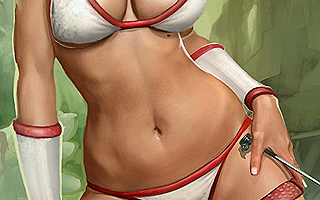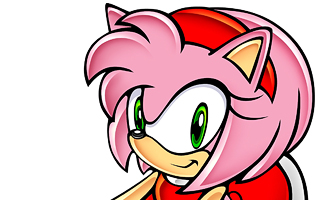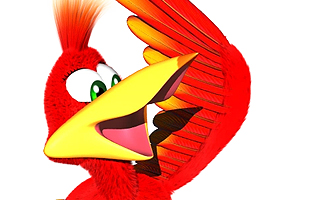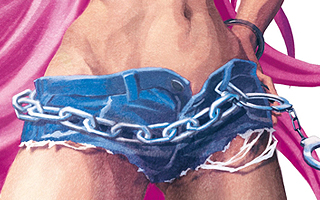Sega CD
Top 10 Best Sega CD Games of All Time!
Sega’s decision to release a CD-ROM add-on for the Genesis seems almost irrational in retrospect, but the Sega CD was very much a product of its era. NEC had recently seen success with their CD-ROM add-on for the PC Engine, and Nintendo had entered a partnership with Sony to release a CD-ROM add-on for the Super NES. The advantages of CDs were clear to all, and most publishers saw the medium as the future of the industry. The Sega CD (or “Mega CD,” as it was known in most territories) housed a faster CPU and added extra hardware functionality, but the biggest selling point was the fact that the CD format allowed for games nearly 320 times larger than typical Genesis cartridges. Sadly, the extra storage capacity was usually used on poorly-implemented full-motion video sequences that added nothing to the gameplay experience. Sega CD sales didn’t approach Genesis numbers, so only a handful of flagship titles were released for the add-on. The library was largely defined by Genesis ports and FMV titles, but some of its games are deserving of a brighter spotlight. Keep in mind that you couldn’t play the Sega CD unless you also had a Sega Genesis. As such, Sega CD games that are also available on Genesis won’t be eligible for this list unless they offer significant improvements over their cartridge-based counterparts.
10
Silpheed
1993

Fast-paced shoot ’em ups like Silpheed were a perfect fit for the Sega CD, and it was quite apparent that the game simply wouldn’t have been possible on the Genesis. The ships and obstacles in Silpheed were all comprised of 3D polygonal shapes. The use of 3D visuals was a rare occurrence in 1993, and Silpheed really stood out from most other 16-bit games. Nintendo’s StarFox (which also hit store shelves in 1993) was widely acclaimed for its revolutionary use of 3D graphics, but Silpheed pushed more polygons and moved along at a faster clip. The backgrounds in Silpheed were comprised of impressive pre-rendered video and allowed the developers to create visual effects that simply could not have been reproduced in real-time. Silpheed was one of those rare titles that actually justified the use of FMV in games. The game sounded fantastic too, and the background music was downright epic. It’s not the best shooter of its era, nor is it the best shooter on the Sega CD. Nevertheless, Silpheed made better use of the Sega CD’s capabilities than perhaps any other game.
9
The Terminator
1993

The Sega CD’s library was full of uninspired Genesis ports, but The Terminator can’t be categorized as such. Instead of simply putting a new coat of paint on an existing product, Virgin Interactive created a unique game with brand new levels, improved animations, and a fantastic soundtrack from Tommy Tallarico that was composed specifically for the Sega CD. The Terminator also made excellent use of the Sega CD’s limited color pallet, and the backdrops really captured the atmosphere of a post-apocalyptic future. Like the movie, The Terminator is centered around a soldier who is engaged in battle with intelligent machines that are bent on the extermination of mankind. The stages closely parallel the environments from the movie, and the game even expands upon the film’s mythos in certain areas. (Before being transported back in time to 1984, players will be given ample opportunity to battle Terminators in the future!) The level structure can be confusing at times and the controls aren’t quite as responsive or intuitive as they could be, but the Sega CD version of The Terminator is still vastly superior to its cartridge-based contemporaries. Ultimately, it’s a rewarding action game that’s deserving of The Terminator name.
8
Final Fight CD
1993

Final Fight is a classic side-scrolling beat ’em up that was originally released in the arcades back in 1989. The basic goal of the game is to beat up endless waves of street thugs and gang members in an effort to rescue a kidnapped girl. Along the way, players will get to stab streetwalkers with knives, hit Andre the Giant look-alikes with lead pipes, and eat meat out of garbage cans. (The game obviously doesn’t take itself too seriously.) One of the best aspects about Final Fight was the option to play as one of three characters. The husky pro-wrestler was the strongest, the modern-day Bushin ninja was the fastest, and the third character was the most balanced. Final Fight was ported to over a dozen gaming platforms, but the Sega CD version was easily the best home version of its day. Certainly, the game improved upon the well-known SNES version in a variety of ways. For instance, the game added some voice acting and featured a remixed soundtrack to take advantage of the CD format. Final Fight CD also looked better than its SNES counterpart. (The Sega CD couldn’t display as many colors as the SNES could, but the game ran at a higher resolution and featured better animation.) An extended intro and an exclusive time attack were also included in the CD version. Unlike the SNES version, Final Fight CD included all three playable characters from the original arcade game. More significantly, the two-player co-op feature was actually left in tact on the Sega CD. Final Fight helped define the beat ’em up genre, and Sega CD owners couldn’t have asked for a better port.
7
Popful Mail
1994

Popful Mail is both an RPG and a 2D action/platformer. The game is built around typical “running and jumping” mechanics, but it also allows players to speak with other characters and manage a vast inventory of items. Popful Mail is set in a whimsical, fantasy-themed world, and features charming characters and a light-hearted storyline. The game’s main character is an elven bounty hunter named Mail who arms herself with a sword. During the game, Mail is eventually joined by a wizard named Tatt and a winged cave-dwelling creature named Caw. The three characters each have their own attacks and they all keep separate health bars. There are unique advantages to each character, and players are free to switch between them on the fly in order to take advantage of their talents. Popful Mail was originally released on the PC-8801 home computer, but the Sega CD version featured new cutscenes, larger sprites, and put more emphasis on platforming elements. It almost felt like a completely different game and seemed to take several cues from the Monster World series. It’s a relatively linear adventure, but Popful Mail is highly entertaining from beginning to end. It’s one of the funniest RPGs of all time.
6
Snatcher
1994

Snatcher is a cyberpunk adventure written and directed by Hideo Kojima and inspired by sci-fi flicks like BladeRunner. Originally released on the NEC PC-8801 and MSX 2 in 1988, Snatcher was later remade for the PC Engine and became a monster hit before finally being released in America on the Sega CD. Visually speaking, Snatcher is one of the most stunning games on the Sega CD and Konami used programming techniques to nearly double the amount of colors that the system could display. The audio was impressive as well, anchored by nearly two-and-a-half hours of speech. While more interactive than its Japanese counterparts, Snatcher still seems to have a bit of an identity crisis in that it feels more like a graphic novel than a game. Fortunately, the compelling characters and well-reasoned scenarios almost make up for the lack of interaction. Perfect balance is achieved in a story that manages to be completely shocking and completely logical at the same time. Although it’s intended for older audiences, Snatcher is one of those rare cases where “mature” means more than just gratuitous violence or scantily-clad women.
5
Robo Aleste
1992

Robo Aleste is a traditional 2D shoot ’em up and a follow-up to M.U.S.H.A. Like its predecessor, Robo Aleste revolves around giant, flying, steam-powered robot samurais in 16th century feudal Japan. The storyline doesn’t make a lot of sense (and the overly lengthy intro doesn’t make things any clearer) but if the concept of “flying robot samurais” doesn’t pique your interest then you probably shouldn’t be playing video games in the first place. Like most Compile shooters, Robo Aleste is loaded with power-ups and weapon upgrades. During the game, players will have the opportunity to arm themselves with throwing knives, ninja stars, bombs, and powerful bolts of electricity. Additionally, there are two flying discs that hover in front of your mecha which can be used to absorb enemy fire or be upgraded with weapons of their own. These weapons wouldn’t really mean much if the game didn’t give you anything to shoot at; and this is one area where Robo Aleste really excels. There is a wide assortment of enemies in the game, and a lot of variety can be seen in their attack patterns. The bosses are imposing, but even the minor enemies can be difficult to destroy. With its fast-paced action and intense gameplay, Robo Aleste is an example of the type of game that should have been more prevalent on the Sega CD.
4
Shining Force CD
1994

One might think that Shining Force CD was nothing more than a port of the Genesis version, but this isn’t the case at all. Rather, the game is actually a remake of the two Shining Force Gaiden games that originally appeared on the Game Gear. Shining Force CD is a massive game that’s comprised of four separate “books.” While the first two books entail the aforementioned Game Gear games, the remaining two focus on a brand new scenario that was made exclusively for the Sega CD. (Characters and stats will be transferred from one book to the next, so a backup RAM cart is essential if you want to progress to the later chapters.) Shining Force CD obviously features better graphics and sound than the Game Gear games did, but the gameplay is largely unchanged. In short, Shining Force CD is still centered around grid-based tactical battles. Players take turns moving, attacking, casting magic, and using items. Between battles, players have the opportunity to manage their inventory, resurrect fallen party members, or promote their characters to higher classes. The Sega CD had a surprisingly solid lineup of RPGs, and Shining Force CD is one of the very best.
3
Earthworm Jim: Special Edition
1995

Earthworm Jim was one of the best platformers of its era. It featured creative level designs, impressive animations, and a ridiculous cast of characters. The designers weren’t afraid to think outside the box, and nearly every level felt radically different from the one that proceeded it. There was a point in time in which seemingly every second game on the market was a platformer, so innovative games like Earthworm Jim were always appreciated. Special Edition was arguably the best version of the game ever released. While the backgrounds lack the detail of the SNES version, it more than makes up for it with Red Book audio, more animations, additional weapons, new secret areas, expanded levels, and a password system. Earthworm Jim seemed destined to become a long-lasting franchise, and it even saw mainstream success with comic books, action figures, and an animated series. Although it had a worthy sequel, the franchise went astray with an ill-advised jump to 3D in 1999. The series may have lost its luster in recent years, but back in the day when platformers were king, Earthworm Jim made his mark with his unforgettable quest to save Princess What’s-Her-Name.
2
Lunar: Eternal Blue
1994

Lunar: Eternal Blue is a traditional turn-based RPG that looks, sounds, and plays like the first Lunar game. I’m acknowledging the sequel because its considerably longer, the story is more dramatic, the magic system is vastly improved, and there is a nekkid girl in the opening movie! Eternal Blue makes great use of the Sega CD’s limited color palette and the simple graphics effectively depict the game’s fantasy setting. The game also takes advantage of the CD format with orchestrated music tracks, voice acting, and over 60 anime-inspired cinematic cutscenes. During the game, you’ll travel from town to town and explore various caves and dungeons along the way. It’s nothing revolutionary, and it doesn’t try to be. Rather than trying to re-invent the wheel, Studio Alex decided to focus on creating charming characters and a compelling story. The game is set 1000 years after the first Lunar, and you’ll even have the opportunity to revisit some of the same areas and see how they’ve changed. The characters, once again, are loaded with personality and their internal struggles give players a real reason to care about them. Many have criticized the translation of the game, but I personally appreciate some light-hearted humor. (Admittedly, the pop culture references are a little out of place and I’m not sure that we really needed references to Bill Clinton or the Neverland Ranch in a fantasy RPG.) In the grand scheme of things, Lunar: Eternal Blue is an entertaining adventure from beginning to end. When you think you’ve finally reached the end, there is an added epilogue adventure that adds several hours onto the game.
1
Sonic CD
1993

Sonic CD had a lot to live up to, as the expectations for Sega’s flagship franchise were sky-high in 1993. While the basic gameplay in Sonic CD is largely unchanged from the first two Sonic games, it still has a few new ideas. The new peel-out maneuver is a nice alternative to the spin dash, the pseudo-3D bonus levels are completely original, and the ability to save your progress is highly appreciated. However, the most significant addition to this game is the time travel aspect. Players are now able to travel to past and future versions of each level, and your actions can either result in a “good” future or a “bad” one. In essence, there are four variations of each of the game’s 21 stages, and attempting to ensure “good futures” in each stage adds a lot of replay value. Sonic CD also supports Q-Sound technology and sounds much cleaner than its Genesis predecessors. Even though the Japanese soundtrack is vastly superior to the American release, I’ll concede that “Sonic Boom” is one catchy theme song. Sonic CD is full of excitement, and the race with Metal Sonic is one of the most intense sequences in the entire series. Sonic CD stays close to the original formula, but it still finds room for innovation. The result is a game that feels completely familiar and completely original at the same time.





Do you agree with this list? Let us know what you think by leaving a comment below. Your opinion matters!